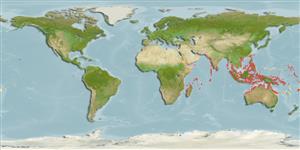>
Blenniiformes (Blennies) >
Blenniidae (Combtooth blennies) > Blenniinae
Etymology: Petroscirtes: Latin, petra, -ae = stone + Greek, skirteo = to jump.
Environment: milieu / climate zone / depth range / distribution range
Écologie
marin récifal; profondeur 1 - 10 m (Ref. 86942). Tropical; 25°N - 24°S
Indo-West Pacific: Sri Lanka to Fiji, north to southern Taiwan and the Yaeyama Islands, south to the southern Great Barrier Reef.
Taille / Poids / Âge
Maturity: Lm ? range ? - ? cm
Max length : 15.0 cm TL mâle / non sexé; (Ref. 9710)
Épines dorsales (Total): 10 - 11; Rayons mous dorsaux (Total): 16-19; Épines anales 2; Rayons mous anaux: 16 - 19. Sexually dimorphic: males are orange-brown while females are sea-green dorsally and lighter below. Similar to P. breviceps in shape but has a blotched, rather than lined pattern on the body. Some color form are probably habitat related. The plain form is mainly green and has numerous tiny pearly spots and occurs in seagrass beds (Ref. 48636).
Adults occur in seagrass beds of shallow lagoons. Also in Sargassum rafts during or immediately after wet season (Ref. 48636). Replaced by P. thepassi at Solomon Islands (Ref. 90102). They feed primarily on small crustaceans and occasionally on scales from fishes. Oviparous. Eggs are demersal and adhesive (Ref. 205), and are attached to the substrate via a filamentous, adhesive pad or pedestal (Ref. 94114). Larvae are planktonic, often found in shallow, coastal waters (Ref. 94114). This form was named by Bleeker (1852) as Petroscirtes bankanensis.
Life cycle and mating behavior
Maturité | Reproduction | Frai | Œufs | Fécondité | Larves
Oviparous, distinct pairing (Ref. 205).
Myers, R.F., 1991. Micronesian reef fishes. Second Ed. Coral Graphics, Barrigada, Guam. 298 p. (Ref. 1602)
Statut dans la liste rouge de l'IUCN (Ref. 130435)
Menace pour l'homme
Harmless
Utilisations par l'homme
Plus d'informations
RéférencesAquacultureProfil d'aquacultureSouchesGénétiqueElectrophoresesHéritabilitéPathologiesTraitementNutrientsMass conversion
CollaborateursImagesStamps, Coins Misc.SonsCiguateraVitesseType de nageSurface branchialeOtolithesCerveauxVision
Outils
Articles particuliers
Télécharger en XML
Sources Internet
Estimates based on models
Preferred temperature (Ref.
123201): 26 - 29.3, mean 28.6 °C (based on 2654 cells).
Phylogenetic diversity index (Ref.
82804): PD
50 = 0.5005 [Uniqueness, from 0.5 = low to 2.0 = high].
Bayesian length-weight: a=0.00562 (0.00258 - 0.01228), b=3.06 (2.87 - 3.25), in cm total length, based on LWR estimates for this (Sub)family-body shape (Ref.
93245).
Niveau trophique (Ref.
69278): 3.1 ±0.43 se; based on food items.
Résilience (Ref.
120179): Haut, temps minimum de doublement de population inférieur à 15 mois (Preliminary K or Fecundity.).
Fishing Vulnerability (Ref.
59153): Low vulnerability (10 of 100).
Nutrients (Ref.
124155): Calcium = 113 [58, 171] mg/100g; Iron = 0.683 [0.413, 1.114] mg/100g; Protein = 18.4 [17.3, 19.4] %; Omega3 = 0.085 [0.048, 0.146] g/100g; Selenium = 21.3 [10.7, 42.6] μg/100g; VitaminA = 124 [40, 369] μg/100g; Zinc = 1.83 [1.25, 2.56] mg/100g (wet weight);
